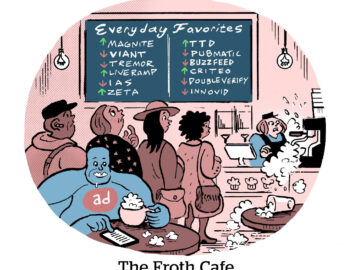

Thank you!
Just one more thing before you go...

lockr Launches APIs To Help Publishers Root Out Burner Emails And Authenticate Real Ones
By Allison Schiff – AdExchanger.
Show me a digital publisher, and I’ll show you a team of people busily doing their best to collect first-party data before the clock runs out on third-party cookies.
But, depending on the site, roughly 5% of the emails publishers collect from their readers – fine, call it zero-party data, if you must – are generated by machines.
Meaning that around 5% of the average email list is “worse than useless,” said Keith Petri, CEO and founder of lockr, a startup that’s part single sign-on (SSO) solution, part email verification and identity matching tool and part consumer-facing inbox management dashboard.
Machine-generated emails are those random alphanumeric burner emails that get spat out by Apple’s Hide My Email, Firefox Relay or any number of smaller companies whose main purpose is to create disposable addresses for people who don’t want to share their real one. (It doesn’t count people who devise their own dummy addresses.)
Not only can’t the data be used for targeting on a publisher’s own site, Petri said, it can’t be matched against an email list provided by an advertiser partner, which puts a damper on marketing deals.
Any percentage of an audience that’s made up of machine-generated emails “is a waste,” said Ryan Nathanson, COO of female-focused publisher SHE Media, which operates BlogHer, SheKnows.com, STYLECASTER and HelloFlo. SHE Media is in the process of setting up a live test with lockr.
“We want to replace [machine-generated emails] with actual identities that can better support our advertising and subscriber business,” Nathanson said.
lockr & loaded
On Tuesday, lockr announced a handful of free APIs that publishers can use to gather first-party data, authenticate real emails and weed out machine-generated emails.
Publishers can upload their email lists to lockr to get a read on which email addresses aren’t usable, and lockr has an API to verify new emails at the point of registration. It also has an SSO to help publishers collect consented email addresses and manage user authentication.
An identity matching API allows publishers to connect multiple email addresses (allison@adexchanger.com, aschiff@gmail.com and oschiffey@hotmail.com, for example) to a single identity tied to a person’s lockrMail address (say, mermaidthecat@lockrmail.com). In that case, four related email addresses are aligned to one lockrMail ID. Publishers only receive hashed versions of a user’s email addresses, so they can be used for targeting but not to identify the individual.
When people sign up for lockr, they link multiple email accounts to make it easier to manage consent and opt-ins across inboxes. Rather than handing out their personal email addresses like candy all over the internet, people can use their lockrMail email to sign up for promotions, check out online and register for newsletters. If a brand starts getting spammy, users can opt out of receiving their messages through their dashboard.
But lockr isn’t a consent management platform (CMP), Petri said, at least not one that’s akin to most of the CMPs that have cropped up to serve the ad tech ecosystem over the past couple of years. Those CMPs exist to share consent strings up and down the supply chain.
“You can think of us more as a personal data management platform,” Petri said.
Because lockr only acts as a connection point between brands and consumers, “publishers can still own their audience, which is important to us,” said Nathanson, who noted that SHE Media is exploring multiple different identity offerings.
“[We] don’t believe there is necessarily a ‘magic’ one-size-fits-all solution to the problem yet,” he said. “Publishers need to find an alternative that enables them to build a direct relationship with their audience.”
Sign (up) of things to come
Speaking of, the industry has glommed onto email and email-based identifiers as a possible replacement for third-party cookies. Unified ID 2.0, developed and backed by The Trade Desk (though now an open-source project), is the most well-known of the bunch.
The growing popularity of disposable emails among consumers, however, is a fly in the UID 2.0 ointment. You can’t create durable IDs based on temporary email addresses.
According to Petri, publishers can use lockr data to support the creation of UIDs, which could also help with adoption.
But lockr is facing a scale challenge of its own. Why would someone click on the “Sign in with lockrMail” button if it’s sitting right next to an SSO widget from Google, Apple or Facebook, all universally recognizable companies?
There’s no silver bullet for that. It’s just going to take time to reach users and educate them about inbox and identity management, Petri said. Which is why lockr’s first step “is to help publishers minimize the negative,” he said, by focusing on email verification and neutralizing the threat of machine-generated emails.
Eventually, if a critical mass of consumers sign up, the hope is that handing them more control over their identity online will make people more comfortable sharing their email address. Petri says he’s already seen it happen during lockr’s alpha.
“This has the potential to change consumer behavior, as long as you don’t abuse your relationship with the consumer,” he said. “If consumers have a sense of control, they are more willing to authenticate.”
View the original article in AdExchanger.

Machine-Generated Email Cost Calculator
Unlock additional revenue by integrating with Identity lockr.
Select your industry vertical.
How many registered users or newsletter subscribers do you have?
Average monthly emails sent to each subscriber per month?
What is your average email open rate?Optional
What is your average email click rate?Optional
Has lockr previously analyzed the machine-generated emails in your first-party data?
What was the percentage?
Enter your RPM (page revenue per 1,000 sessions).
What is your average monthly subscriber growth rate?
What is your anonymous web visitors monthly pageview traffic?
What is your authenticated monthly pageview traffic?
Projected Incremental Revenue
Projected Annual MGE Overhead
| MGE Fees | $0 |
| MGE Lost Email Revenue | $0 |
| MGE Advertising Leakage | $0 |
| One month of Email Jail | $0 |
| Incremental Revenue | $0.0M |
Enter your email to receive the full report.
Are you sure you want to leave?
Changes you made will not be saved.







